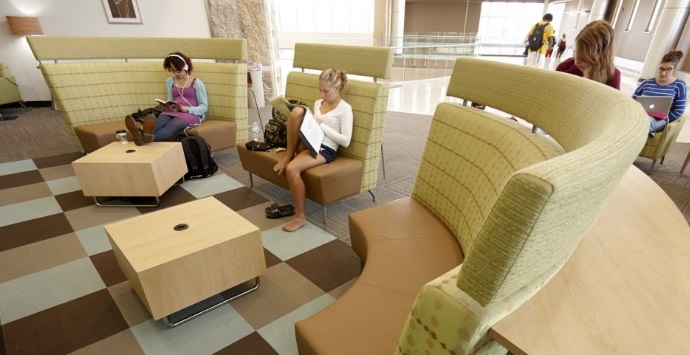What can corporate workspace learn from learning environments?
It shouldn’t come as a surprise that 95 percent of corporations are recruiting their future work force on college and university campuses. What is surprising is that zero percent were studying how the design of learning environments can be incorporated into the design of their corporate workspaces.
This was the initial finding of my research and partnership with Jonathan Webb, vice president and workplace strategist at KI, over the past five years. KI is an international commercial furniture manufacturer based in Green Bay, Wisconsin. Jonathan and I struck up a conversation in 2012 on the heels of a project I had recently completed for a business school at one of the California State Universities. At first we thought that colleges and universities should look at how corporations design their workspaces, but then it turned into an ‘a-ha!’ moment when we considered the converse — that corporations should be taking design and planning cues from institutions of higher education because of the influence these learning environments have had on a newly graduating workforce.
Shortly after releasing our initial research findings, it became clear that we needed to go further and take our corporate clients back to college! We called our effort C2C (Corporate to College) and added new companies into the mix. We wanted organizations to observe learning environments for themselves and consider how they might apply higher education planning principles to their work environments. So we took several representatives from various companies on a tour through various college campuses.
 A study area on the Madison College campus in Madison, Wisconsin, visited during our college tour.
A study area on the Madison College campus in Madison, Wisconsin, visited during our college tour.
It was a unique opportunity to capture immediate reactions, such as “Wow, we should do that,” or “I didn’t expect to see this.” Hearing this feedback from the companies gave us the opportunity to update our findings in our latest whitepaper, “Collegiate Design: The New Driver for Workplace Design,” which was released in March 2017.
A few of the things we observed:
- Students work everywhere—park benches, soft seating, stairwells, hallways, wide-open areas, noisy environments, quiet confines.
- As clients were quick to notice, college is a constant blend of work and social interaction. They occur simultaneously and shift easily and instantly. It could be noted that the cultural beginnings of work/life balance start here.
- Technology is an integral and seamless part of students’ work styles. During a tour, a client marveled at a student who was working in a technology lab and asked to take her photo. She was using no fewer than four devices—an active desktop, a MacBook, a tablet displaying content, and of course a smart phone for music and texting.
- Campus collaborative spaces are more highly used by groups of students than corporate collaborative spaces are used by individual employees.
We were glad to conclude our research with some initial recommendations for our clients —and to think about how we can apply our findings to our own corporate workspaces.
To learn more, check out our podcast on The Culture Chat!






